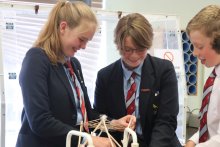
This week saw the return of the annual Physics Olympics competition – the first in-person competition since 2019. Twenty-three schools took part this year in a day of physics challenges. Visiting schools had travelled from as far away Newcastle, Yarm and Barnard Castle, having to set off really early for the trip over to York. Schools from York, Harrogate, and Leeds were also well represented.
The teams were:
| Archimedes | All Saints RC Secondary |
| Aristotle | Archbishop Holgate’s School |
| Becquerel | Ashville College |
| Chadwick | Barnard Castle School |
| Curie | Bootham School |
| Doppler | Cundall Manor |
| Einstein | Durham Cathedral Schools Foundation |
| Faraday | Fulford School |
| Feynman | Gateways School |
| Galileo | Harrogate Ladies’ College |
| Hawking | Holy Family High School |
| Joule | King James’s School |
| Kelvin | Manor CE Academy |
| Kepler | Pocklington School |
| Lawrence | Queen Ethelburga’s Collegiate |
| Leavitt | Royal Grammar School Newcastle |
| Meitner | Scarborough College |
| Newton | St Aidan’s Church of England High School |
| Ohm | St Peters (8-13) |
| Oppenheimer | The Grammar School at Leeds |
| Planck | Vale of York Academy |
| Rutherford | Yarm School |
The teams took part in a broad range of physics, maths, problems solving and practical skills. There were five different laboratory-based challenges in all and a very challenging Fermi Quiz.
In the labs, the challenges were:
- Potential Energy – Constructing a lattice frame using wooden splints and loom bands to achieve the maximum GPE of some steel nuts and bolts.
- Light Fantastic – Using a diffraction grating, pupils produce a calibration curve using known wavelength LEDs to then find the wavelength of a mystery LED.
- Animal Crackers – Determining the upthrust of a helium balloon animal and weight of a soft toy, by the principle of moments.
- Turbocharged – Pupils construct a fan powered boat, which is powered by a super-capacitor, that is itself charged using solar cells.
- Sun Scream – Ranking different SPF of sun creams using a UV light source and UV sensor.
The Fermi Quiz requires pupils to estimate various different quantities to the nearest power of 10. e.g How fast would a 1:76 scale model of an LNER Azuma train need to be travelling, to have the same momentum as the real thing, when travelling at maximum speed? (answer to the nearest power of ten m/s) Each challenge has a numerical outcome, allowing the teams to be ranked. Prizes are then awarded for the teams winning each of the challenges, and an overall gold, silver and bronze.
All of the pupils got stuck into the challenges right from the beginning and had lots of fun taking part in the challenges. Feedback from the pupils about the day was very positive. They said that they were surprised by… “all the fun experiments we got to do and how fast the day went by”, “How well we worked as a team and we’re able to tackle tough challenges”. Pupils said they were interested in “new concepts and ideas introduced during the competition”, “…the activities with water or particularly messy things, it brings out the fun in my opinion.”
By an astounding feat of organisation, the final results took just 30 minutes to calculate at the end of the day. The winners for the Fermi Quiz challenge who will receive the Morris Shield Fulford School. Yarm school were the overall winners, with Gateways School in second place and RGS Newcastle in third.
"As always there was an incredible team effort from all of the staff involved at St Peter’s this year. I am also grateful also to all of the Lower Sixth physics pupils that helped with the challenges and the general running of the day." - Mr Parr, Head of Science at St Peter's School








